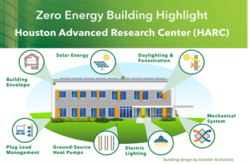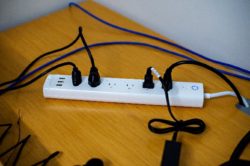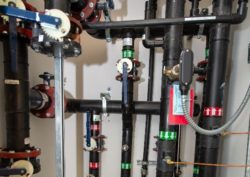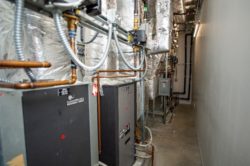

The American Council for an Energy-Efficient Economy (ACEEE) highlighted HARC’s LEED and Net-Zero Energy certified building as a part of the Department of Energy’s Zero Energy Building (ZEB) program. Kate Sweater Hickcox, a Sustainability Scientist at the Pacific Northwest National Laboratory (PNNL), presented the study on HARC.
Zero energy buildings (ZEBs) operate highly efficiently and produce enough clean energy on-site to meet or exceed their energy usage annually. HARC’s building serves as a Living Lab, showcasing how energy efficiency helps to create a healthier environment.
 HARC’s building envelope protects against thermal bridging and moisture problems in Texas’s hot and humid climate. Air leakage for the building is 75% less than the standard operational measurements.
HARC’s building envelope protects against thermal bridging and moisture problems in Texas’s hot and humid climate. Air leakage for the building is 75% less than the standard operational measurements.
The majority of HARC’s power comes from renewable energy. The south orientation and slope of the roof were designed specifically for solar panels. With 252 roof-mounted PV panels, HARC saves significantly in electricity costs and avoids over 85,000 pounds of CO2 emissions annually.
 The interior environment of the over 18,000-square-foot building is light and bright. One-inch, double-pane insulated windows are placed to balance heat gains and losses with the comfort of employees. The views open into a wooded area, and daylight provides offices with interior light.
The interior environment of the over 18,000-square-foot building is light and bright. One-inch, double-pane insulated windows are placed to balance heat gains and losses with the comfort of employees. The views open into a wooded area, and daylight provides offices with interior light.
The lighting fixtures use LEDs with >90 lumens/Watt. Their suspended design provides direct/indirect linear lighting with minimal glare to assure comfort. Sensors dim or turn off 95% of lights when not needed, and sensor settings adjust to suit occupant preferences.
 An additional energy-conserving measure is the use of plug loads, or energy used by equipment plugged into an outlet. Portable meters and a commercial platform monitor and analyze daily energy consumption. Changes help to prevent waste, and plug loads help to minimize waste with automatic power-downs and monitoring capabilities.
An additional energy-conserving measure is the use of plug loads, or energy used by equipment plugged into an outlet. Portable meters and a commercial platform monitor and analyze daily energy consumption. Changes help to prevent waste, and plug loads help to minimize waste with automatic power-downs and monitoring capabilities.
 To help the building stay cool in the summer and warm on cooler days, HARC uses Ground-Source Heat Pumps (GSHPs). The 15 high-efficient GSHPs use near-contact subsurface temperatures to dispel and absorb heat. The 36 heat exchange wells below the parking lot are 300 feet deep and 20 feet apart within a row, with 25 feet between rows. Sensors at various depths in a ground-exchange loop monitor wells and send data to the building automation system for staff to review and analyze.
To help the building stay cool in the summer and warm on cooler days, HARC uses Ground-Source Heat Pumps (GSHPs). The 15 high-efficient GSHPs use near-contact subsurface temperatures to dispel and absorb heat. The 36 heat exchange wells below the parking lot are 300 feet deep and 20 feet apart within a row, with 25 feet between rows. Sensors at various depths in a ground-exchange loop monitor wells and send data to the building automation system for staff to review and analyze.
 HARC’s mechanical system is a fixed-plate energy recovery ventilator with enthalpy heat exchangers that provide all ventilation and exhaust air and uses the return temperature of the heat pump to precondition incoming air. In 2019, the system achieved an energy use intensity (EUI) of 6.1 kBtu/ft2, accounting for just 41% of HARC’s total electricity use that year. These steps to maintain a ZEB are essential to HARC’s mission to daily reduce its carbon footprint.
HARC’s mechanical system is a fixed-plate energy recovery ventilator with enthalpy heat exchangers that provide all ventilation and exhaust air and uses the return temperature of the heat pump to precondition incoming air. In 2019, the system achieved an energy use intensity (EUI) of 6.1 kBtu/ft2, accounting for just 41% of HARC’s total electricity use that year. These steps to maintain a ZEB are essential to HARC’s mission to daily reduce its carbon footprint.
Read more in the two publications produced by the Pacific Northwest National Laboratory:
ZERO ENERGY BUILDING HIGHLIGHT: Houston Advanced Research Center (Summary)
ZERO ENERGY BUILDING HIGHLIGHT: Houston Advanced Research Center (Full Report)